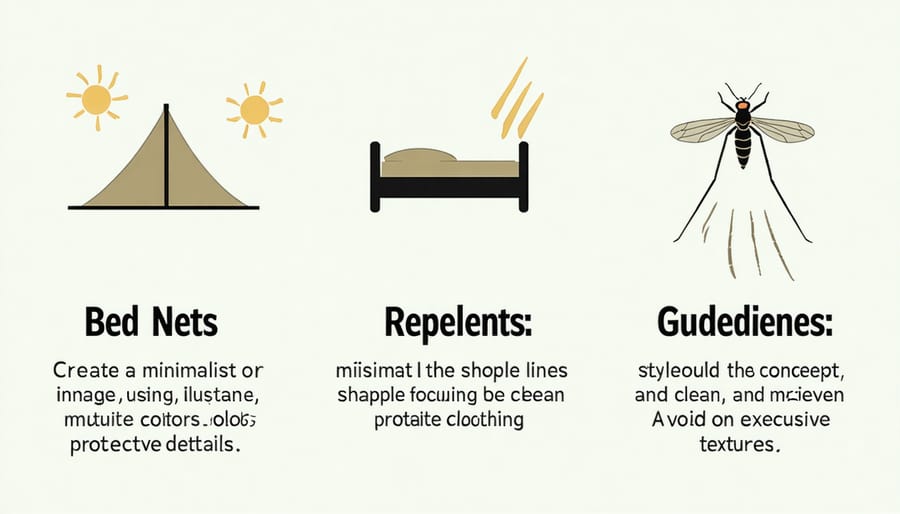Malaria stands as one of the world’s most significant vector-borne diseases, transmitted exclusively through the bite of infected Anopheles mosquitoes. This life-threatening illness affects millions globally each year, making it a crucial public health concern even for Albertans who travel internationally. While our province’s cold climate naturally protects us from local malaria transmission, understanding this disease remains vital for anyone planning trips to affected regions, particularly in tropical and subtropical areas. The mosquito’s role as a vector – an organism that carries and transmits disease-causing pathogens – makes malaria a classic example of how vector-borne diseases spread through intricate biological relationships. Unlike directly transmitted illnesses, malaria’s reliance on mosquitoes as intermediary hosts creates unique challenges for prevention and control, but also offers specific opportunities for protection through targeted measures like insect barriers and preventive medications.
Understanding Malaria as a Vector-Borne Disease
How Mosquitoes Transmit Malaria
Female Anopheles mosquitoes act as nature’s delivery system for malaria parasites. When an infected mosquito bites a person, it releases microscopic parasites into the bloodstream through its saliva. These parasites, called Plasmodium, first travel to the liver where they multiply silently. After about a week, they burst out into the blood and begin infecting red blood cells, causing the symptoms we associate with malaria.
The cycle continues when another mosquito bites an infected person. The mosquito picks up the parasites along with the blood meal, and these parasites develop inside the mosquito over 10-12 days. Once mature, they move to the mosquito’s salivary glands, ready to infect the next person bitten.
This transmission process makes malaria a classic example of a vector-borne disease, where mosquitoes serve as the vectors (carriers) that spread the infection between people.
The Plasmodium Parasite’s Journey
The journey of the Plasmodium parasite, which causes malaria, is quite remarkable. It begins when an infected mosquito bites a person, injecting the parasite into their bloodstream. These microscopic organisms first travel to the liver, where they multiply quietly for about a week without causing any symptoms. Once ready, they burst from the liver cells and enter red blood cells, where they continue to multiply.
Every few days, the infected blood cells burst, releasing more parasites into the bloodstream. This cycle triggers the typical fever and chills associated with malaria. When another mosquito bites an infected person, it picks up the parasites, allowing them to develop further inside the mosquito before the cycle begins again with the next human bite.
Understanding this lifecycle helps explain why malaria symptoms can come and go, and why proper treatment timing is crucial for recovery.

Vector-Borne Diseases in Alberta: What’s Different?
Common Vector-Borne Diseases in Alberta
While malaria isn’t found locally, vector-borne diseases in Alberta do pose health concerns for residents. The most common include West Nile virus, transmitted by mosquitoes typically active during summer months, and Lyme disease, carried by ticks that emerge in spring and fall. Rocky Mountain spotted fever, though rare, can also occur through tick bites in our region.
These diseases tend to be seasonal, with the highest risk during warmer months when insects are most active. The good news is that our cold winters help limit the year-round presence of disease-carrying insects. However, climate change is gradually affecting these patterns, potentially extending the active season for these vectors.
Local health authorities actively monitor these diseases and provide regular updates to help residents stay informed. Prevention strategies like using insect repellent, wearing protective clothing, and checking for ticks after outdoor activities are essential parts of staying healthy in our region.
Why Malaria Isn’t Endemic to Alberta
Alberta’s climate and geography create natural barriers that prevent malaria from becoming endemic in our region. The Anopheles mosquitoes that transmit malaria require specific environmental conditions to survive and reproduce – particularly warm, humid weather and standing water that remains above 16°C for extended periods. Our province’s cold winters, low humidity, and relatively short summers make it impossible for these mosquitoes to establish permanent populations.
While climate change and disease threats are increasingly concerning for our region, Alberta’s altitude and drainage patterns also work in our favor. Most of our province sits at elevations where malaria-carrying mosquitoes cannot thrive, and our natural watersheds typically don’t create the kind of stagnant water bodies these vectors need.
Additionally, our robust public health infrastructure and mosquito control programs help maintain this malaria-free status by monitoring and controlling local mosquito populations. This combination of natural and human-made protections ensures that while Albertans may need to worry about malaria when traveling abroad, it’s not a concern at home.
Travel Health: Protecting Yourself from Malaria

Prevention Strategies
Protecting yourself from malaria requires a comprehensive approach to mosquito bite prevention, especially when traveling to affected regions. Understanding local environmental health factors is crucial for effective prevention.
Start by using EPA-registered insect repellents containing DEET, picaridin, or IR3535. Apply these to exposed skin and clothing, following package instructions carefully. Wear long-sleeved shirts and long pants, especially during dawn and dusk when mosquitoes are most active.
Make your accommodation mosquito-proof by ensuring windows and doors have intact screens. Sleep under insecticide-treated bed nets in areas where screening isn’t available. Remove standing water around your living space, as these are prime mosquito breeding grounds.
If traveling to malaria-risk areas, consult your healthcare provider about antimalarial medications at least 4-6 weeks before departure. Different regions require different medications, and some need to be started before travel.
For Albertans planning trips to tropical regions, visit a travel health clinic for personalized advice. They can provide region-specific recommendations and necessary prescriptions. Remember that prevention strategies may need adjustment based on your destination, season of travel, and length of stay.
Keep these preventive measures in place throughout your entire stay in malaria-risk areas and continue medication as prescribed after returning home.
When to Seek Medical Advice
Before traveling to malaria-risk areas, schedule a consultation with your healthcare provider at least 4-6 weeks before departure. This allows time to start preventive medications and receive proper vaccination guidance. Your doctor can assess your specific health needs and travel plans to provide tailored advice.
Seek immediate medical attention if you develop symptoms during or after visiting malaria-endemic regions, especially within the first year after return. Key warning signs include fever, chills, headache, and flu-like symptoms. Don’t wait to see if symptoms improve on their own, as early treatment is crucial for the best outcomes.
For Albertans planning international travel, visit a travel health clinic or your family doctor to discuss malaria prevention. They can provide up-to-date information about risk areas and recommend appropriate preventive measures based on your destination and health status.
Keep detailed records of your travel history and share this information with healthcare providers, as it helps them make accurate diagnoses. If you experience any unusual symptoms after returning home, mention your recent travel to malaria-risk areas during medical consultations.
Remember that some antimalarial medications need to be continued for several weeks after leaving the risk area. Follow your healthcare provider’s instructions carefully, even if you feel well after returning home.
In conclusion, malaria is indeed a vector-borne disease transmitted through infected mosquitoes. While Albertans are fortunate to live in an area where local malaria transmission doesn’t occur, staying informed about prevention is crucial, especially when traveling to affected regions. Remember to consult with travel health clinics before visiting malaria-risk areas, use appropriate mosquito protection measures, and take prescribed antimalarial medications as directed. By understanding the vector-borne nature of malaria and taking proactive steps, you can significantly reduce your risk of infection. If you’re planning travel to malaria-endemic regions, start your prevention planning early and maintain awareness of current health advisories. Your health is in your hands, and prevention is always better than treatment.

